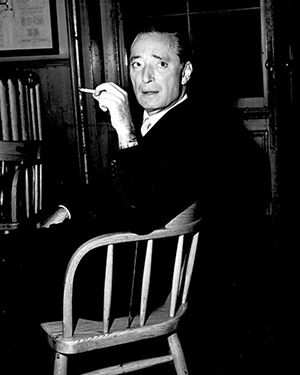Robert Harrison (publisher)
Robert Harrison (April 14, 1904 – February 17, 1978) was an American journalist and publisher, known internationally for sensational news stories. He worked for the New York Evening Graphic, the Motion Picture Herald and was publisher of Confidential magazine.
He was born Max Harrison, the youngest child and only son of Benjamin Harrison (February 1868 – 1933) and Pauline Harrison (July 1870–?), Jewish immigrants from Lithuania (then the Russian Empire). Max grew up in New York City, first in lower Manhattan and later the Bronx, with three sisters, who doted on “the baby” of the family. As a young child Max decided to replace his birth name with "Robert." Early on Robert appeared magnanimous, if only due to a tendency to quickly forget slights as he could be not bothered to focus on the negative. In school he did poorly at math but well at English. He wanted to write for a living. At the age of 12 he authored and published a travel guide to roadside inns, Harrison's Weekend Guide. After the printer refused to give Harrison his share of the profits, Harrison formed a belief that one could only trust family members, whom he would later employ in various publishing projects. But years later, his generous nature would lead him to make an exception at the height of his success with an ex-McCarthyite editor with deadly repercussions.
As a teen, Harrison attended Stuyvesant High School for two years before dropping out. He would later attend night classes at Columbia University.
During the 1920s Harrison began his journalistic career as a copy boy for Bernarr McFadden's New York Evening Graphic, an ancestor of the supermarket tabloids that would emerge in the 1960s. Called the "Pornographic" by detractors for its emphasis on sex, crime and violence, it would provide many of the themes that Harrison would use as a publisher. Among his coworkers were a sportswriter, Ed Sullivan, and a crime reporter, Samuel Fuller. Harrison also met his future hero and mentor, Walter Winchell. At the Graphic Harrison worked his way up to advertising space salesman. But before the paper failed in 1932, Harrison worked eight months as a reporter. One of his first stories was about a Ziegfeld Follies showgirl clad only in balloons. After the Graphic shutdown, Harrison sold song lyrics and returned to writing travel guides (for Cook's). His father, Benjamin Harrison, was a working-class coppersmith who scoffed at what he called "air business"—advertising and journalism—he wanted his son to become a carpenter. But Robert persisted after his father's death in 1933. In 1935 Harrison joined the editorial staff of the Motion Picture Herald, a film trade publication whose conservative Catholic owner, Martin Quigley, Sr., had close ties to the Hays Office. Quigley would himself author the decency guidelines with Jesuit Daniel A. Lord that became known as the “Hays Code.” In 1935 Quigley in sent Harrison to the Hollywood offices of Quigley Publishing. There Harrison collected publicity photos of would-be actresses sent by agents. While in Hollywood, the idea of a magazine began to form.
...
Wikipedia

